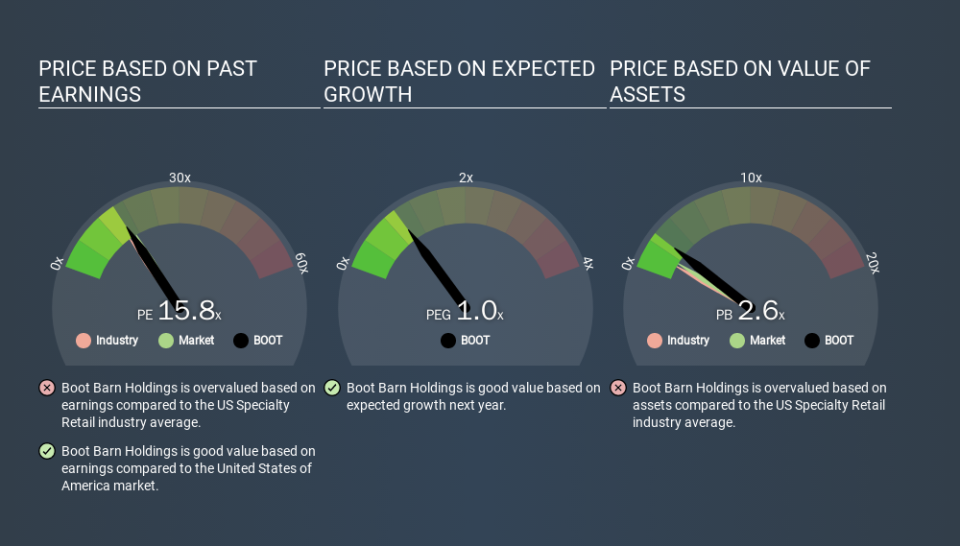How Does Boot Barn Holdings's (NYSE:BOOT) P/E Compare To Its Industry, After The Share Price Drop?

To the annoyance of some shareholders, Boot Barn Holdings (NYSE:BOOT) shares are down a considerable 33% in the last month. Indeed, the recent drop has reduced the annual gain to a relatively sedate 2.6% over the last twelve months.
Assuming nothing else has changed, a lower share price makes a stock more attractive to potential buyers. In the long term, share prices tend to follow earnings per share, but in the short term prices bounce around in response to short term factors (which are not always obvious). The implication here is that long term investors have an opportunity when expectations of a company are too low. One way to gauge market expectations of a stock is to look at its Price to Earnings Ratio (PE Ratio). A high P/E implies that investors have high expectations of what a company can achieve compared to a company with a low P/E ratio.
View our latest analysis for Boot Barn Holdings
Does Boot Barn Holdings Have A Relatively High Or Low P/E For Its Industry?
Boot Barn Holdings's P/E of 15.82 indicates some degree of optimism towards the stock. As you can see below, Boot Barn Holdings has a higher P/E than the average company (14.2) in the specialty retail industry.
That means that the market expects Boot Barn Holdings will outperform other companies in its industry. The market is optimistic about the future, but that doesn't guarantee future growth. So further research is always essential. I often monitor director buying and selling.
How Growth Rates Impact P/E Ratios
Generally speaking the rate of earnings growth has a profound impact on a company's P/E multiple. If earnings are growing quickly, then the 'E' in the equation will increase faster than it would otherwise. Therefore, even if you pay a high multiple of earnings now, that multiple will become lower in the future. Then, a lower P/E should attract more buyers, pushing the share price up.
Boot Barn Holdings increased earnings per share by a whopping 34% last year. And earnings per share have improved by 26% annually, over the last five years. With that performance, I would expect it to have an above average P/E ratio.
A Limitation: P/E Ratios Ignore Debt and Cash In The Bank
Don't forget that the P/E ratio considers market capitalization. Thus, the metric does not reflect cash or debt held by the company. Theoretically, a business can improve its earnings (and produce a lower P/E in the future) by investing in growth. That means taking on debt (or spending its cash).
Such spending might be good or bad, overall, but the key point here is that you need to look at debt to understand the P/E ratio in context.
Boot Barn Holdings's Balance Sheet
Net debt totals 13% of Boot Barn Holdings's market cap. This could bring some additional risk, and reduce the number of investment options for management; worth remembering if you compare its P/E to businesses without debt.
The Bottom Line On Boot Barn Holdings's P/E Ratio
Boot Barn Holdings has a P/E of 15.8. That's around the same as the average in the US market, which is 16.6. Given it has reasonable debt levels, and grew earnings strongly last year, the P/E indicates the market has doubts this growth can be sustained. Given analysts are expecting further growth, one might have expected a higher P/E ratio. That may be worth further research. What can be absolutely certain is that the market has become significantly less optimistic about Boot Barn Holdings over the last month, with the P/E ratio falling from 23.5 back then to 15.8 today. For those who prefer to invest with the flow of momentum, that might be a bad sign, but for a contrarian, it may signal opportunity.
Investors should be looking to buy stocks that the market is wrong about. If the reality for a company is not as bad as the P/E ratio indicates, then the share price should increase as the market realizes this. So this free report on the analyst consensus forecasts could help you make a master move on this stock.
Of course, you might find a fantastic investment by looking at a few good candidates. So take a peek at this free list of companies with modest (or no) debt, trading on a P/E below 20.
If you spot an error that warrants correction, please contact the editor at editorial-team@simplywallst.com. This article by Simply Wall St is general in nature. It does not constitute a recommendation to buy or sell any stock, and does not take account of your objectives, or your financial situation. Simply Wall St has no position in the stocks mentioned.
We aim to bring you long-term focused research analysis driven by fundamental data. Note that our analysis may not factor in the latest price-sensitive company announcements or qualitative material. Thank you for reading.

